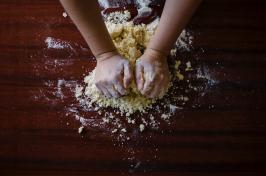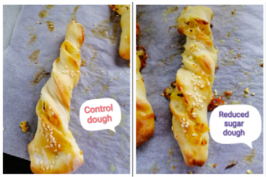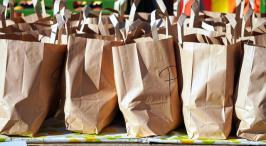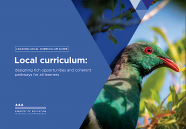Food technology – Key ingredient in cross-curricular learning
"We set the challenge for our students to take their new knowledge home and share it with whānau through home cooking."
Irma Cooke, SCL technology and Karen Locke, science teacher at Rototuna Junior High School
Learning modules at Rototuna Junior High School
Part of Rototuna Junior High School’s (RJHS) vision is to be future-oriented and embrace emerging technologies. With this in mind, Specialist Curriculum Leader (SCL) of technology Irma Cooke teamed up with a few of her colleagues to develop cross-curricular learning.
RJHS’s graduate profile “Ourselves as learners” — which is about self-managing, self-awareness, and motivation — was the focus of each learning plan. Irma noted, “Food technology is the optimal context for learners to develop these essential skills.”
In choosing a collaborative approach and setting tasks linked to real-world situations, each module fosters an .
The learning modules that emerged are:
- Food technology and te reo Māori
- Food technology and science
- Food technology and English.
Shared kai and conversation
Food technology and te reo Māori
Nadine Malcom-Cant, SCL of languages and te reo Māori teacher, and Irma Cook paired to teach a year 7 and 8 Food technology and te reo Māori module called "Kai and Who Am I?"

Photo by Life Of Pix: https://www.pexels.com/photo/person-mixing-dough-9095/
The aim of the project was to create a menu item for a Matariki celebration. Early on, senior school student Matua Anarau shared a portion of his nanny's rēwena bread-starter for the module to keep.
Local experts in the food industry served as classroom instructors. They shared their knowledge of traditional and contemporary recipes, the stories behind the creations, what they knew about Māori cuisine, and how to find and use natural, indigenous ingredients.
The menu brief
In the brief development, students were instructed to create an indigenous menu item that focused on traditional and contemporary ingredients. Their creations had to meet the needs of stakeholders attending a Matariki lunch.
Learning in this context supports learning languages level 1 achievement objectives.
Specifications
The menu item must:
- include one or more foraged ingredients
- be developed within 100 minutes
- include in-season vegetables or fruits
- be finger food (something easy to eat without cutlery).
The kōrero requirements
When serving the kai to the 120 guests at the Matariki luncheon, students had to speak te reo Māori. Students also shared their pepeha during the event.
Some of their kōrero with the guests included the following.
- He rēwena māu?
- He reka!
- He pararua parai māu?
- Ae koe.
These prerequisites align with learning languages level 2 achievement objectives.
"What we already knew is that one of the most authentic ways to experience a culture, the language, traditions, and history is through food."
Irma Cooke, SCL technology RJHS
The chemistry of cooking
Food technology and science
Food technology teacher Irma Cooke and science teacher Karen Lock co-taught a unit centred on curriculum areas technological products and chemistry. Students considered the reactions that occurred in food preparation. They discovered these were similar to the reactions they had observed in science class.
Irma and Karen tapped into students' prior knowledge. Students understood that in food science, questions needing answers arise. Building on this understanding, the teachers supported students. They developed lessons that led students to consider how ingredients interact and behave when cooked at different temperatures.
This lines up with technological practice of level 3 achievement objective.
Factors affecting the rate of a chemical reaction

developed by year 8 student during lockdown.
A key stage of the process was students exploring fermentation in kombucha. Drawing on scientific methods, they experimented with changes in temperature and concentration. They observed and recorded effects on the rate of fermentation.
From this, students learned the importance of a “control” — having one sample where the answer is known. They applied the step of establishing a control when they made rēwena bread. They experimented in many ways such as changing the time for the dough to rise or lowering the baking temperature.
The use of acids in cooking
In addition, students experimented with acids and bases. Investigating the nature of acids, students realised that acids used in marinades can both marinate protein and cook it.
Students took their learning home. They created marinades, tested pH level, and shared what they found with the class.
Literacy and technology meet
"Students looked through a critical lens, just like a food technologist would in the real world."
Irma Cooke and Jo Brooks, teachers RJHS
Food technology and literacy
A module that teachers Irma Cooke, Jo Brooks, and Ginny Taylor put together ensured year 7 and 8 students could engage with “kindness and respect”, one of RJHS’s graduate profiles.
The brief development, inspired by “My Food Bag”, guided students to explain common food-related issues in the community and to consider how they could provide a prepared meal that would meet stakeholders’ needs.
The task provided students with the opportunity to develop delivered food bags suitable to those who are “time poor” or who have dietary requirements such as dairy-free or gluten-free meals. One group investigated people who have halal dietary needs.
Tasks in this module align with technological practice of level 3 achievement objective and speaking, writing, and presenting level 1 achievement objectives.
Recipe trials and refining the product

Image by Matthias Böckel from Pixabay.
Working in groups, students refined their prototype over three trials. They researched cooking methods, altered flavours, tested combinations, and tweaked the menu.
Feedback from teachers and peers and sustained focus on stakeholders guided students as they trialled their menu items.
Literary focus
Students made static images of their own RJHS Food Bag logos, bag designs, and recipe cards. In addition, they researched design concepts and how to create recipes. Their research included interviewing a sample of stakeholders.
As a result of the research process, students were able to how and why their menus met client needs.
You might also like ...
Leading Local Curriculum Guide series
This guide series has been developed to deliberately steer your curriculum and assessment review and design decisions as you strengthen your local curriculum.


